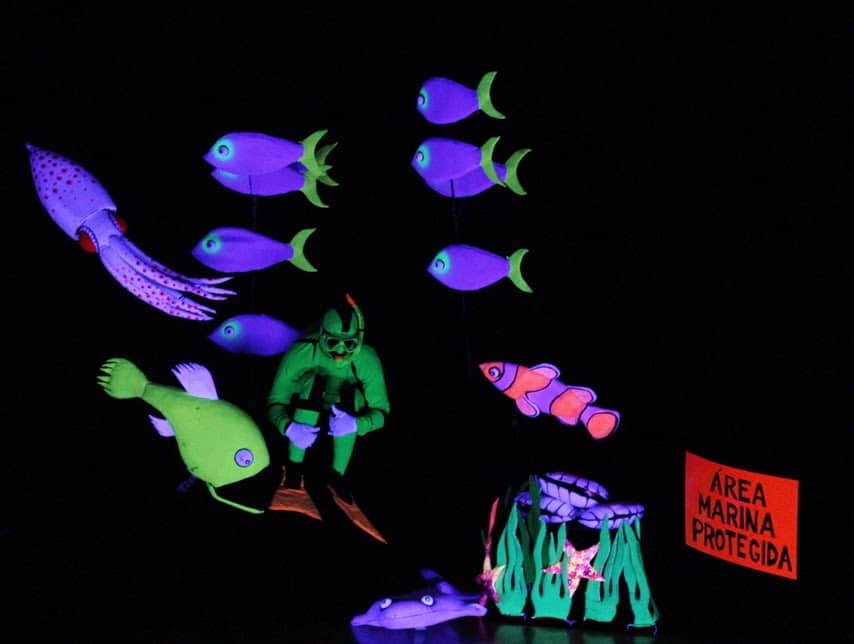As a story, “Sonrisa de Tiburón” isn’t all that complicated: An explorer flies a plane to a distant island, then scuba-dives into the surrounding waters. Fish and oysters emerge, each interacting with the explorer in a different way. Halfway through the show, we see evil anglers catching sharks and mutilating them in order to prepare shark fin soup.
Translated as “Shark Smile,” the touring show is a family-friendly celebration of marine wildlife with a social message in its middle. The theater company Ex-Ánima wants its audience to think critically about commercial fishing and to embrace underwater life forms. While there is no text or dialogue to say so, the island in the piece is supposed to represent Isla del Coco, a Costa Rican territory and one of the most famous shark habitats in the world.
But Ex-Ánima’s real triumph is its technical sophistication: “Shark Smile” is a “black light” show, a genre that started in Europe in the 1960s and has wowed audiences ever since. Like moving Lava Lamps, the actors and props are painted in colors sensitive to ultraviolet light. The dark room, black background, and colorless costumes make everything invisible except for deliberately glowing colors and forms.
While these special effects could represent anything, Ex-Ánima uses the black light to illustrate the darkest depths of the ocean. Schools of fish swim in collaborative patterns. Sharks stalk in slow circles. Sea turtles float along in formation. The actors have clearly studied the movements of marine animals, and they believably mimic that physicality. Even the explorer swims like an actual scuba diver, and it takes long minutes to guess how his entire body levitates above the dark stage.
The shark-finning section is staged as shadow-puppetry, and given the long history of shadow puppets as tools of protest, this part of the show is particularly powerful. We see fisherman hooking sharks and slicing off their fins, collecting them at the docks in buckets, then selling them to restaurants.
The scene isn’t exactly tactful: The soup is ultimately set before a figure in a sedge hat, who slurps up the soup with a large spoon. By using the iconic East Asian headgear, “Shark Smile” unambiguously blames such poaching on the Chinese. While demand for shark fins is highest in China, the costume could be construed as unnecessary race baiting (so to speak). Remember, this is a show for kids.
Political correctness quibbles aside, “Shark Smile” is a wondrous production, and when the lights come up and the performers take their bow, it’s astonishing to realize that there are only six of them. Lasting less than an hour, “Shark Smile” packs a lot of images into a short period, making it a perfect family excursion.
Then again, the show will appeal equally – and maybe more so – to adults. When I attended a special noon performance at the National Theater (this weekend’s shows will take place at the National Cultural Center or CENAC), the auditorium was packed, and the mean age was probably 40. While kids will enjoy the animals, adults will appreciate the inventive staging. It’s hard to imagine pantomiming oceanic movement and synchronizing with five other people in complete darkness. Black light theater requires a physical self-awareness and attention to rhythm that most of us couldn’t imagine. If you’ve never seen this kind of live performance before, “Shark Smile” is a worthy maiden voyage.
“Sonrisa de Tiburón” plays Sept. 12-14 at CENAC, downtown San José. Fri. & Sat., 8 p.m.; Sun., 2 p.m. 2,000-4,000 ($4-8). Info: RedCultura.






